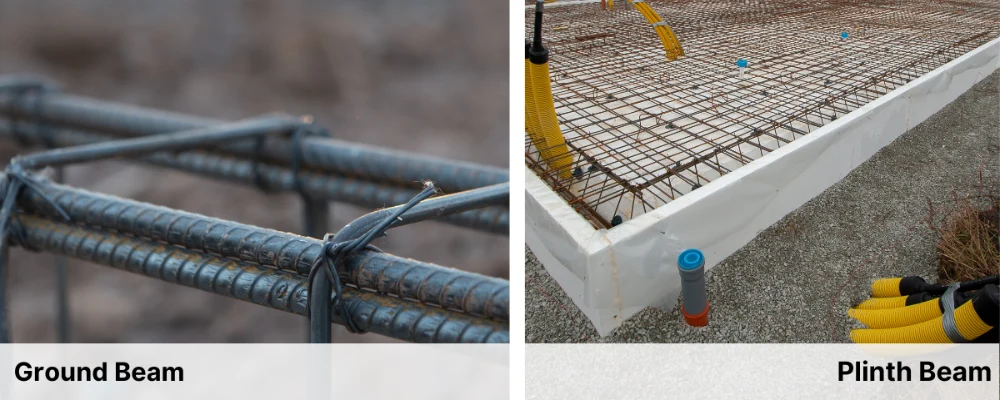In construction, beams are key to keeping structures stable and strong. The ground beams and plinth beams are particularly important elements of a building’s substructure and first floors. Although they may appear similar at first sight and sometimes are even used interchangeably, a ground beam and a plinth beam are distinct and are employed in distinct manners. This guide will therefore focus on what they are, their role, construction, and the increasing importance of beams in current construction practices.
Getting to Know Ground Beams

Ground beams are horizontal building parts that builders place at or just below the ground. They have an essential role: to hold up a building’s weight and move it to the foundation or the soil underneath. Ground beams play a crucial role when the soil can’t support much weight or when the ground isn’t level, which could lead to instability.
Main Jobs of Ground Beams
- Load Distribution: Ground beams distribute the weight of walls and columns across the soil or foundation. This helps stop uneven settling.
- Structural Support: They give extra support to buildings on soft or uneven ground, acting as a stabilising part.
- Leveling: People use ground beams to level a building’s foundation on sloping land. This makes sure the structure sits on a stable and flat base.
- Bridging Weak Soil: By spanning areas of weak soil, ground beams can make a stable base that improves the overall strength of the structure.
Construction of Ground Beams
Building ground beams involves several main steps, including:
- Design: To design ground beams, engineers consider the building’s load needs and the soil’s geotechnical features. They figure out the right size and reinforcement details to keep things safe and stable.
- Material: Builders make ground beams from reinforced concrete, which offers the needed strength and durability. They put steel bars (rebar) inside the concrete to make it stronger when pulled.
- Formwork: Before pouring the concrete, workers set up forms to shape the beam. They remove these forms once the concrete hardens.
- Reinforcement: Reinforcement: Reinforcement bars are the steel materials that are fitted in the formwork as per the design and tied together to form a grid-like like structure to improve the strength of concrete.
- Pouring Concrete: Members add water to the cement and place the mixture over the reinforcement in the formwork. They then shake it around to allow it to flow into all the voids and eliminate air pockets.
- Curing: As in the case of ground beams, curing is critical to concrete strength and performance.
Ground Beams vs Plinth Beams
Ground beams and plinth beams might sound alike, but they serve different purposes and have unique uses. Let’s take a closer look at how these two differ:
| Feature | Ground Beam | Plinth Beam |
| Location | At or just below ground level | At the plinth level, just above ground level |
| Primary Purpose | Transfer loads to the soil or foundation | It provides lateral support and, prevents cracking |
| Function | Load distribution and leveling | Load transfer and seismic resistance |
| Construction Material | Reinforced concrete | Reinforced concrete |
| Use in Construction | Used where soil bearing capacity is weak | Used in all types of buildings for stability |
| Load Bearing | Directly supports walls and columns | Primarily supports walls and prevents tilting |
Importance of Ground Beams and Plinth Beams in Construction
Ground beams and plinth beams are essential in building construction. Here’s why we can’t do without them:
Benefits of Ground Beams
- Better Stability: Ground beams make buildings more stable on uneven or soft ground. This reduces the chance of the building settling or getting damaged.
- More Design Options: They let builders be more creative with their designs. This means we can build on tricky sites where normal foundations might not work.
- Handling Weight: Ground beams spread out the weight of the building. This helps to manage stress and stop weak spots from forming in the structure.
Benefits of Plinth Beams
- Structural Integrity: Plinth beams keep walls in line and intact, reducing the chance of harm from foundation shifts or outside forces.
- Protection: Plinth beams lift the structure up. This guards against damp and water getting in, which can cause long-term decay.
- Seismic Resistance: In places that often have earthquakes, plinth beams play a key role. They boost the building’s ability to stand up to sideways forces.
Challenges in Building Ground Beams and Plinth Beams
Ground beams and plinth beams offer many good points. But building them has its own set of problems:
- Complex Design Requirements: Accurate design plays a key role in making sure these beams do their job well. This calls for exact calculations and a solid grasp of how soil behaves.
- Material Quality: The grade of concrete and reinforcement used has a big impact on how well both ground and plinth beams work. Low-grade materials can cause the beams to fail or not last as long.
- Environmental Considerations: Buildings need to consider things like temperature, moisture, and soil conditions. These factors can change how the beams are set and perform over time.
- Cost Implications: Adding these beams can increase the overall cost of building a structure. This is true if the project needs special materials or building methods.
Tips for Successful Construction of Ground Beams and Plinth Beams
Here are some hands-on tips to make sure you build ground beams and plinth beams correctly :
- Check Out the Site: You need to understand the soil and how much weight it’ll carry (load-bearing capacity) to design beams that work well.
- Material Selection: Buy top-notch concrete and steel to make your beams strong and long-lasting.
- Stick to the Plan: Follow what the structural engineers tell you to do as per specifications.
- Let It Set: Give the beams enough curing time to dry out so they prevent cracks and get as strong as they should.
- Regular Monitoring: Look things over often to spot and fix any problems while you’re building.
Conclusion
Ground beams and plinth beams play a key role in building safe, stable, and long-lasting structures. Though they have different functions, both beam types are essential to manage loads, prevent structural problems, and boost a building’s overall strength. When builders and engineers understand their functions, building methods, and hurdles, they can use these beams well to create lasting structures. Whether dealing with challenging soil or trying to improve earthquake resistance, smart use of ground beams and plinth beams is vital for successful building projects.

